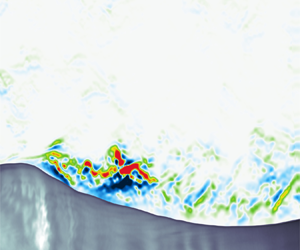Article contents
Turbulent and wave kinetic energy budgets in the airflow over wind-generated surface waves
Published online by Cambridge University Press: 14 June 2021
Abstract

The momentum and energy exchanges at the ocean surface are central factors determining the sea state, weather patterns and climate. To investigate the effects of surface waves on the air–sea energy exchanges, we analyse high-resolution laboratory measurements of the airflow velocity acquired above wind-generated surface waves using the particle image velocimetry technique. The velocity fields were further decomposed into the mean, wave-coherent and turbulent components, and the corresponding energy budgets were explored in detail. We specifically focused on the terms of the budget equations that represent turbulence production, wave production and wave–turbulence interactions. Over wind waves, the turbulent kinetic energy (TKE) production is positive at all heights with a sharp peak near the interface, indicating the transfer of energy from the mean shear to the turbulence. Away from the surface, however, the TKE production approaches zero. Similarly, the wave kinetic energy (WKE) production is positive in the lower portion of the wave boundary layer (WBL), representing the transfer of energy from the mean flow to the wave-coherent field. In the upper part of the WBL, WKE production becomes slightly negative, wherein the energy is transferred from the wave perturbation to the mean flow. The viscous and Stokes sublayer heights emerge as natural vertical scales for the TKE and WKE production terms, respectively. The interactions between the wave and turbulence perturbations show an energy transfer from the wave to the turbulence in the bulk of the WBL and from the turbulence to the wave in a thin layer near the interface.
- Type
- JFM Papers
- Information
- Copyright
- © The Author(s), 2021. Published by Cambridge University Press
References
REFERENCES
- 16
- Cited by



